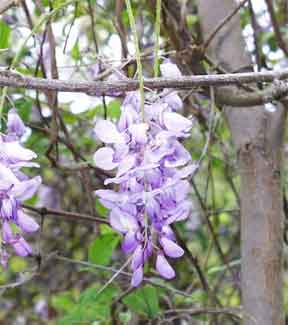The Japanese Wisteria is a popular ornamental vine that is tough and hardy and forms thickets in which little else can grow. It can climb trees and shrubs to a height of 20 meters. Often, it constricts the stems of trees and kills them by girdling. Its stout, white-barked stem is woody and grows up to 16 cm in diameter.
Wisteria twines clock-wise round its host and has compound leaves that are 20-30 cm long and have 13 to 19 leaflets. The fragrant pea-like flowers, which are purple, blue-purple, or lilac-blue in color, are 1.5-2 cm long and bloom from April to July. The fruits are flattened pods that are 10-15 cm long. They mature from July to November.

Wisteria is a perennial vine that can live for more than 50 years. Vegetative reproduction is the main means of expansion, and many stolons develop new roots and shoots at short intervals. It can also produce many seeds in favorable conditions.
Wisteria was introduced as an ornamental vine from Japan around 1830. It was popular in the Southern US and was used to decorate walls, gazebos, porches and gardens. It is hardy enough to be found in New England and even further north. Of the 10 species of Wisteria, only two are native to the US; the rest belong to Asia.
The Japanese vine is hardier and more invasive than the native species and it can be recognized by its fragrant flowers. It requires the full sun, but can survive in partial shade also. It grows well in loamy, deep and well drained soil, though it adapts easily to a variety of soil conditions.
Wisteria can be controlled by cutting it close to the root collar. This method can be used on small populations or as pre-treatment on large sites. It can also be employed in places where herbicide cannot be used. Wisteria has a long life, and can flower for 50 years.



{ 0 comments… add one now }
You must log in to post a comment.